Data-Driven, Web-Based Parameter Identification for a Reduced-Order Model of the Chilean Power System
Abstract
:1. Introduction
2. Frequency Dynamic Model
3. Synchrophasor Network and PMU Hardware
4. Data Analytics Algorithms
4.1. Algorithm for Contingency Identification
4.2. Inertia Identification
4.3. Droop Estimation
4.4. Power Unbalance Estimation
4.5. Estimation of , , and
5. Web-Based Application
5.1. Back-End Development
5.2. Front-End Development
Contingency Size
6. Conclusions and Future Work
Author Contributions
Funding
Institutional Review Board Statement
Informed Consent Statement
Data Availability Statement
Conflicts of Interest
References
- Rezkalla, M.; Pertl, M.; Marinelli, M. Electric power system inertia: Requirements, challenges and solutions. Electr. Eng. 2018, 100, 2677–2693. [Google Scholar] [CrossRef] [Green Version]
- Abed, E.H.; Namachchivaya, N.S.; Overbye, T.J.; Pai, M.A.; Sauer, P.W.; Sussman, A. Data-Driven Power System Operations. In Proceedings of the Computational Science—ICCS 2006, Reading, UK, 28–31 May 2006; Hutchison, D., Kanade, T., Kittler, J., Kleinberg, J.M., Mattern, F., Mitchell, J.C., Naor, M., Nierstrasz, O., Pandu Rangan, C., Steffen, B., et al., Eds.; Lecture Notes in Computer Science. Springer: Berlin/Heidelberg, Germany, 2006; Volume 3993, pp. 448–455. [Google Scholar] [CrossRef]
- Wang, Q.; Li, F.; Tang, Y.; Xu, Y. Integrating Model-Driven and Data-Driven Methods for Power System Frequency Stability Assessment and Control. IEEE Trans. Power Syst. 2019, 34, 4557–4568. [Google Scholar] [CrossRef]
- Khan, M.; Li, M.; Ashton, P.; Taylor, G.; Liu, J. Big data analytics on PMU measurements. In Proceedings of the 2014 11th International Conference on Fuzzy Systems and Knowledge Discovery (FSKD), Xiamen, China, 19–21 August 2014; pp. 715–719. [Google Scholar] [CrossRef] [Green Version]
- Yang, D.; Wang, B.; Cai, G.; Chen, Z.; Ma, J.; Sun, Z.; Wang, L. Data-Driven Estimation of Inertia for Multiarea Interconnected Power Systems Using Dynamic Mode Decomposition. IEEE Trans. Ind. Inform. 2021, 17, 2686–2695. [Google Scholar] [CrossRef]
- Zhou, Y.; Arghandeh, R.; Spanos, C.J. Partial Knowledge Data-Driven Event Detection for Power Distribution Networks. IEEE Trans. Smart Grid 2018, 9, 5152–5162. [Google Scholar] [CrossRef]
- Tianxia, J.; Zhuoyuan, G.; Huadong, S.; Pengfei, G.; Jun, Y.; Shiyun, X.; Bing, Z. Data-driven Research Method For Power System Stability Detection. In Proceedings of the 2018 International Conference on Power System Technology (POWERCON), Guangzhou, China, 6–8 November 2018; pp. 3061–3069. [Google Scholar] [CrossRef]
- Zhang, J.; Xue, A.; Bi, T.; Wang, Z.; Tang, W. On-Line Synchronous Generator’s Parameters Identification with Dynamic PMU Data. In Proceedings of the 2012 Asia-Pacific Power and Energy Engineering Conference, Shanghai, China, 27–29 March 2012; pp. 1–4. [Google Scholar] [CrossRef]
- Gorbunov, A.; Dymarsky, A.; Bialek, J. Estimation of Parameters of a Dynamic Generator Model from Modal PMU Measurements. In Proceedings of the 2020 IEEE Power & Energy Society General Meeting (PESGM), Montreal, QC, Canada, 3–6 August 2020. [Google Scholar] [CrossRef]
- Hua, K.Q.; Vahidnia, A.; Mishra, Y.; Ledwich, G. PMU measurement based dynamic load modeling using SVC devices in online enviroment. In Proceedings of the 2015 IEEE PES Asia-Pacific Power and Energy Engineering Conference (APPEEC), Brisbane, Australia, 15–17 November 2015; pp. 1–5. [Google Scholar] [CrossRef] [Green Version]
- Regulski, P.; Wall, P.; Rusidovic, Z.; Terzija, V. Estimation of load model parameters from PMU measurements. In Proceedings of the IEEE PES Innovative Smart Grid Technologies, Europe, Istanbul, Turkey, 12–15 October 2014; pp. 1–6. [Google Scholar] [CrossRef]
- Shetye, K.S.; Jang, W.; Overbye, T.J. System Dynamic Model Validation using Real-Time Models and PMU Data. In Proceedings of the 2018 Clemson University Power Systems Conference (PSC), Charleston, SC, USA, 4–7 September 2018; pp. 1–7. [Google Scholar] [CrossRef]
- Segundo Sevilla, F.R.; Liu, Y.; Barocio, E.; Korba, P.; Andrade, M.; Bellizio, F.; Bos, J.; Chaudhuri, B.; Chavez, H.; Cremer, J.; et al. State-of-the-art of data collection, analytics, and future needs of transmission utilities worldwide to account for the continuous growth of sensing data. Int. J. Electr. Power Energy Syst. 2021, 137, 107772. [Google Scholar] [CrossRef]
- Zografos, D.; Ghandhari, M. Estimation of power system inertia. In Proceedings of the 2016 IEEE Power and Energy Society General Meeting (PESGM), Boston, MA, USA, 17–21 July 2016; pp. 1–5. [Google Scholar]
- Makolo, P.; Zamora, R.; Lie, T.T. Heuristic Inertia Estimation Technique for Power Networks with High Penetration of RES. In Proceedings of the 2020 2nd International Conference on Smart Power & Internet Energy Systems (SPIES), Bangkok, Thailand, 15–18 September 2020; pp. 356–361. [Google Scholar] [CrossRef]
- Makolo, P.; Oladeji, I.; Zamora, R.; Lie, T.T. Data-driven inertia estimation based on frequency gradient for power systems with high penetration of renewable energy sources. Electr. Power Syst. Res. 2021, 195, 107171. [Google Scholar] [CrossRef]
- Conseil International des Grands Réseaux Électriques; Comité d’Études C4. Review of on-Line Dynamic Security Assessment Tools and Techniques; OCLC: 470553818; CIGRÉ: Paris, France, 2007. [Google Scholar]
- Zhang, R.; Xu, Y.; Dong, Z.Y.; Meng, K.; Xu, Z. Intelligent systems for power system dynamic security assessment: Review and classification. In Proceedings of the 2011 4th International Conference on Electric Utility Deregulation and Restructuring and Power Technologies (DRPT), Weihai, China, 6–9 July 2011; pp. 134–139. [Google Scholar] [CrossRef]
- Sun, S.; Yan, J.; Yu, Z.; Lv, Y.; Lu, G.; Shi, D.; Xie, C. Research of power system online dynamic security assessment application expansion. In Proceedings of the 10th International Conference on Advances in Power System Control, Operation & Management (APSCOM 2015), Hong Kong, China, 8–12 November 2015; pp. 1–6. [Google Scholar] [CrossRef]
- Liu, Y.; Cui, Y.; Yu, W.; Zhang, Y.; Wu, L.; You, S.; Liu, Y. Recent application examples of FNET/GridEye. In Proceedings of the 2018 IEEE 12th International Conference on Compatibility, Power Electronics and Power Engineering (CPE-POWERENG 2018), Doha, Qatar, 10–12 April 2018; pp. 1–6. [Google Scholar] [CrossRef]
- You, S.; Zhao, J.; Yao, W.; Liu, Y.; Cui, Y.; Wu, L.; Guo, J.; Liu, Y. FNET/GridEye for Future High Renewable Power Grids—Applications Overview. In Proceedings of the 2018 IEEE PES Transmission & Distribution Conference and Exhibition-Latin America (T&D-LA), Lima, Peru, 18–21 September 2018; pp. 1–5. [Google Scholar] [CrossRef]
- FNET/GridEye Web Display. Available online: http://fnetpublic.utk.edu/index.html (accessed on 1 July 2021).
- Decker, I.; Dotta, D.; Agostini, M.; Zimath, S.; de Silva, A. Performance of a synchronized phasor measurements system in the Brazilian power system. In Proceedings of the 2006 IEEE Power Engineering Society General Meeting, Montreal, QC, Canada, 18–22 June 2006; p. 8. [Google Scholar] [CrossRef]
- Decker, I.C.; e Silva, A.S.; da Silva, R.J.G.; Agostini, M.N.; Martins, N.; Prioste, F.B. System wide model validation of the Brazilian Interconnected Power System. In Proceedings of the IEEE PES General Meeting, Minneapolis, MN, USA, 25–29 July 2010; pp. 1–8. [Google Scholar] [CrossRef]
- Implementation of Inertia Monitoring in ERCOT—What’s It All about. Available online: https://www.esig.energy/implementation-of-inertia-monitoring-in-ercot-whats-it-all-about/ (accessed on 1 July 2021).
- ‘Sonar of the Power Grid’: New Inertia Measurement Tools Planned for Great Britain’s Electricity System. Available online: https://www.nationalgrideso.com/news/sonar-power-grid-new-inertia-measurement-tools-planned-great-britains-electricity-system (accessed on 1 July 2021).
- Measurements Inertia. Available online: https://www.reactive-technologies.com/grids/gridmetrix/ (accessed on 1 July 2021).
- Digital Energy Effective Inertia. Available online: https://www.ge.com/digital/sites/default/files/download_assets/effective-inertia-datasheet-ge-grid-analytics.pdf (accessed on 1 July 2021).
- Kezunovic, M.; Pinson, P.; Obradovic, Z.; Grijalva, S.; Hong, T.; Bessa, R. Big data analytics for future electricity grids. Electr. Power Syst. Res. 2020, 189, 106788. [Google Scholar] [CrossRef]
- Chavez, H.; Hezamsadeh, M.R.; Carlsson, F. A Simplified Model for Predicting Primary Control Inadequacy for Nonresponsive Wind Power. IEEE Trans. Sustain. Energy 2016, 7, 271–278. [Google Scholar] [CrossRef]
- Ørum, E.; Kuivaniemi, M.; Laasonen, M.; Bruseth, A.I.; Jansson, E.A.; Danell, A.; Elkington, K.; Modig, N. Future System Inertia; ENTSO-E: Brussels, Belgium, 2015. [Google Scholar]
- Proyecto MedFasee: Monitoreo del Sistema Eléctrico en Tiempo Real. Available online: http://www.medfasee.ufsc.br/conosur/ (accessed on 1 July 2021).
- Quiroz, J.; Chavez, H. Towards On-line PMU-based Model Calibration for Look-ahead Frequency Analysis. In Proceedings of the 2019 IEEE Milan PowerTech, Milan, Italy, 23–27 June 2019; pp. 1–5. [Google Scholar] [CrossRef]
- Quiroz, J.; Pérez, R.; Chávez, H.; Matevosyan, J.; Segundo Sevilla, F.R. A Hardware Implementation of an Online Frequency Dynamic Parameter Estimation. In Proceedings of the 2021 IEEE Madrid PowerTech, Madrid, Spain, 28 June–2 July 2021; pp. 1–6. [Google Scholar] [CrossRef]
- Mukherjee, R.; De, A. Real-time dynamic security analysis of power systems using strategic PMU measurements and decision tree classification. Electr. Eng. 2020, 103, 813–824. [Google Scholar] [CrossRef]

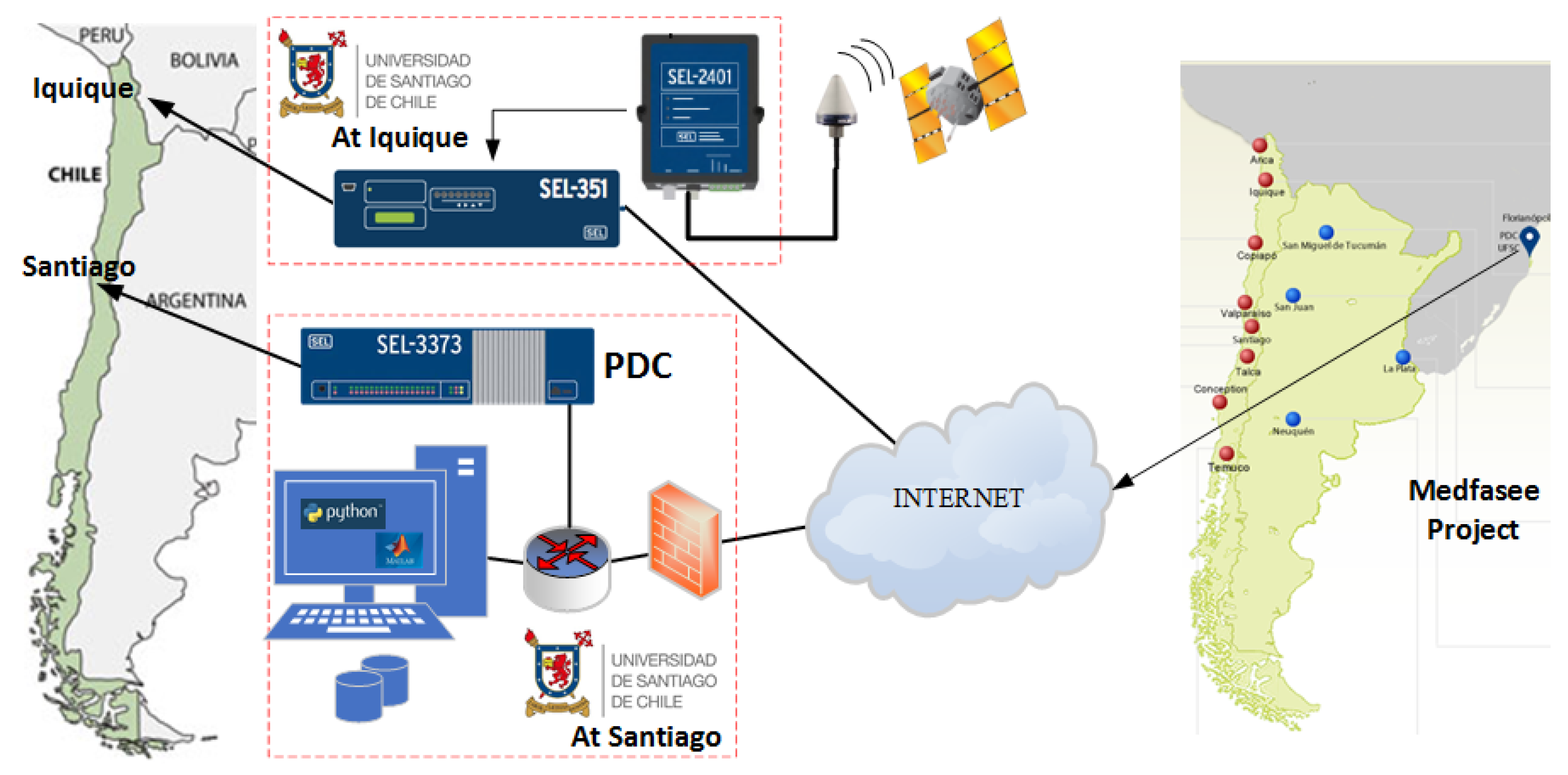
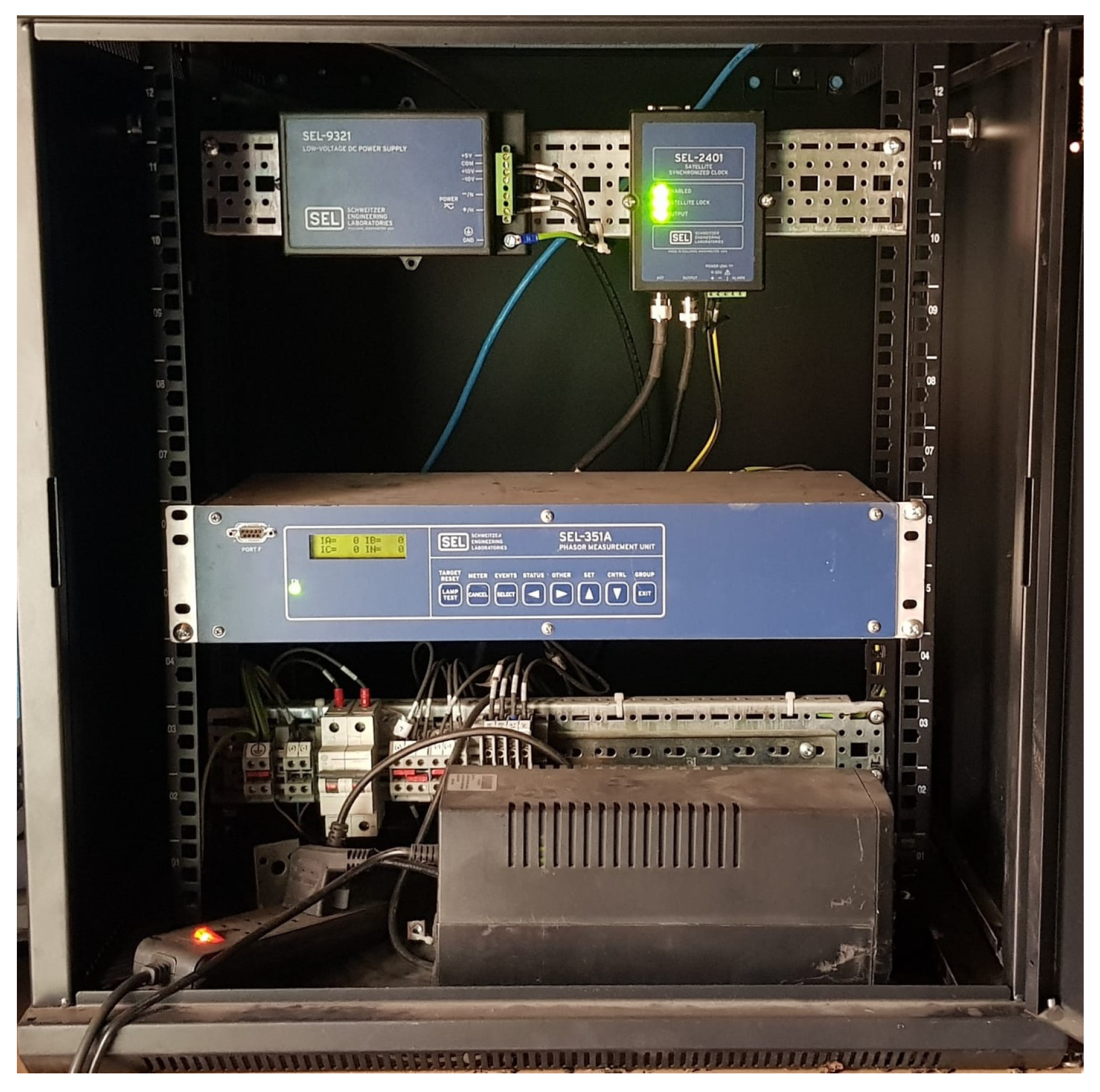


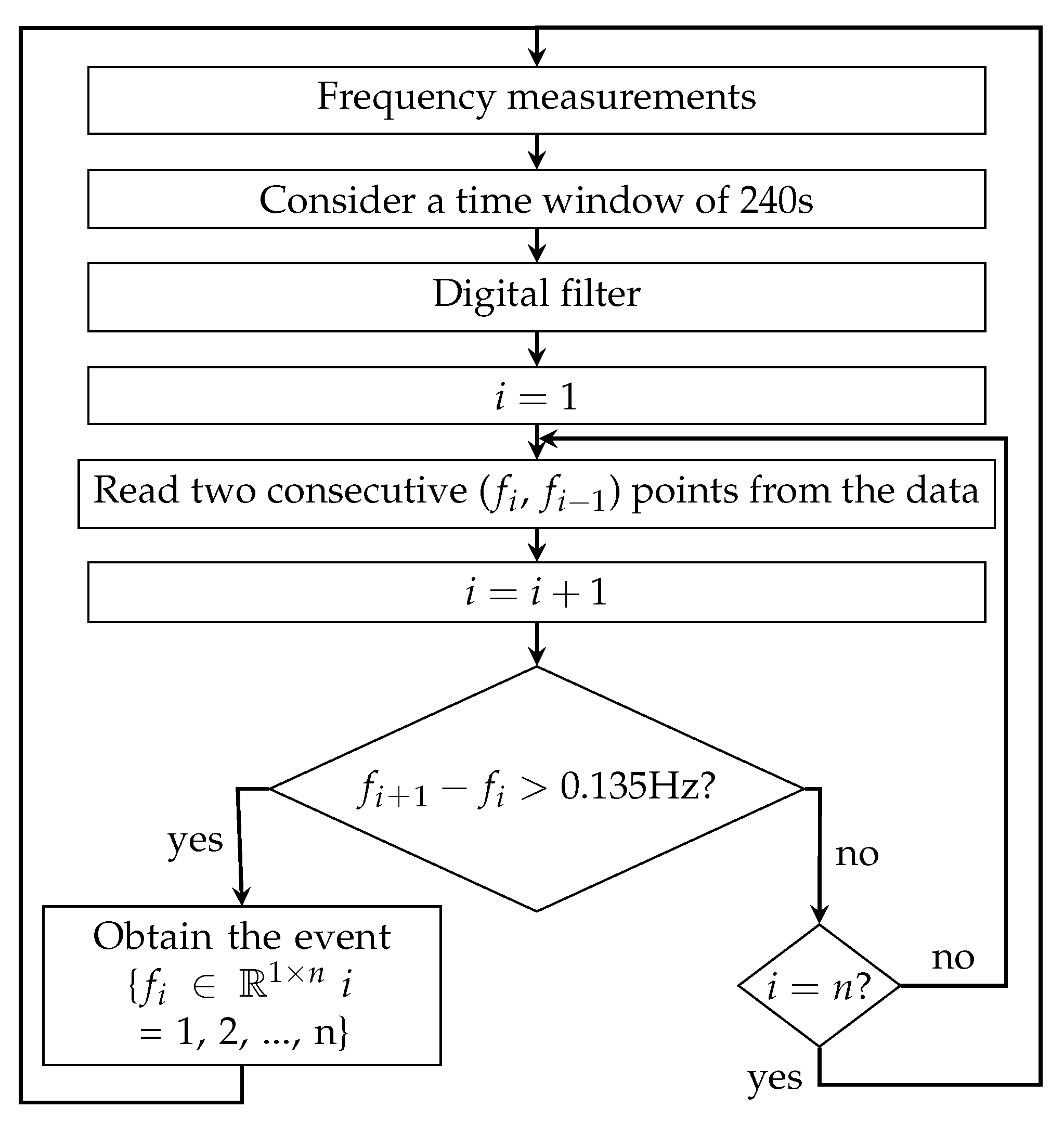
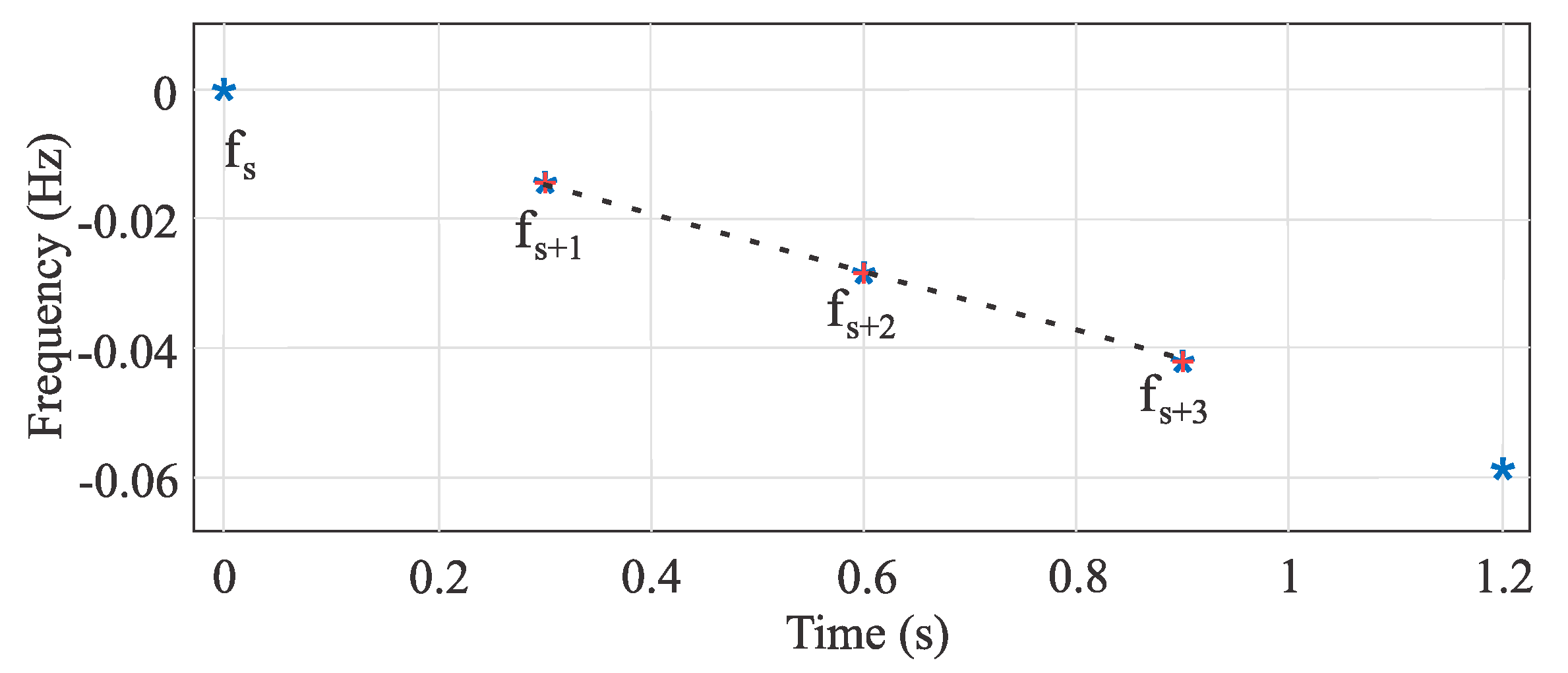

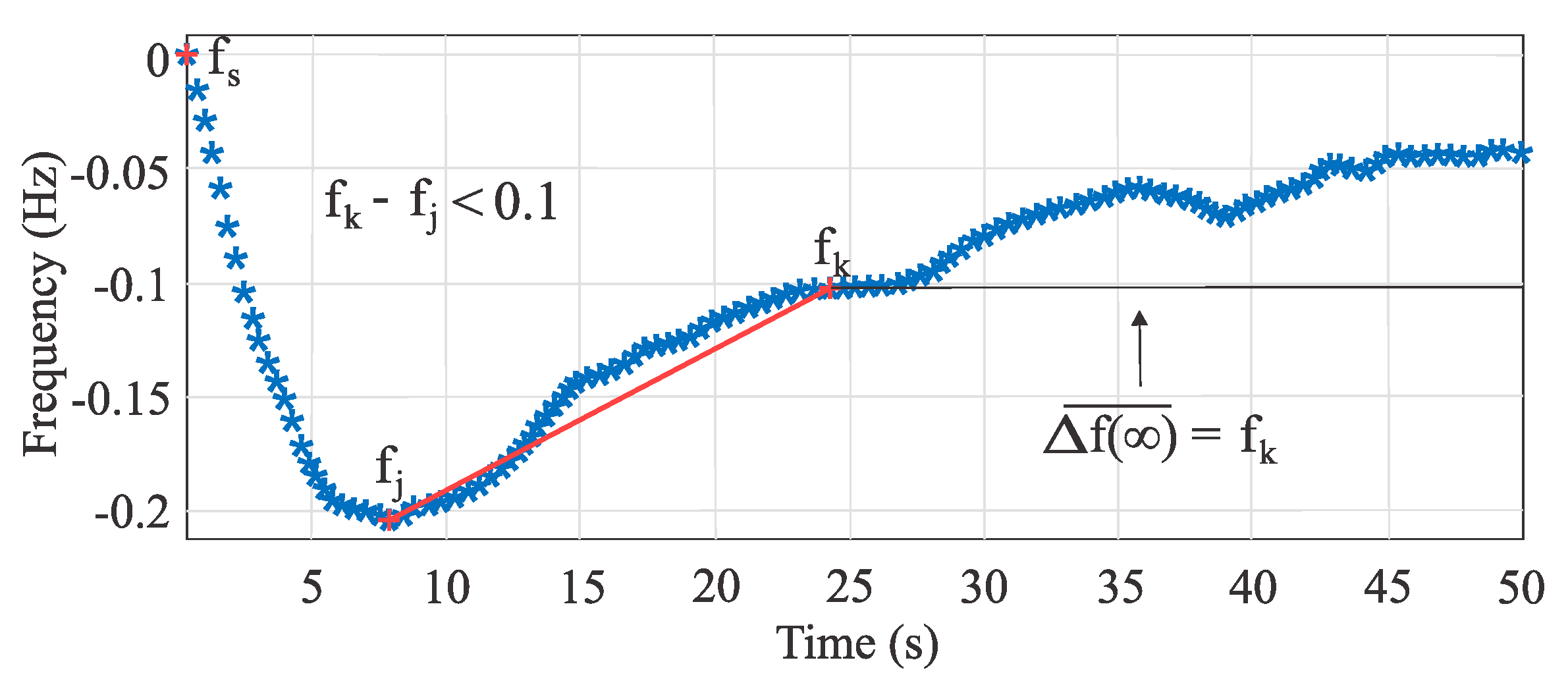
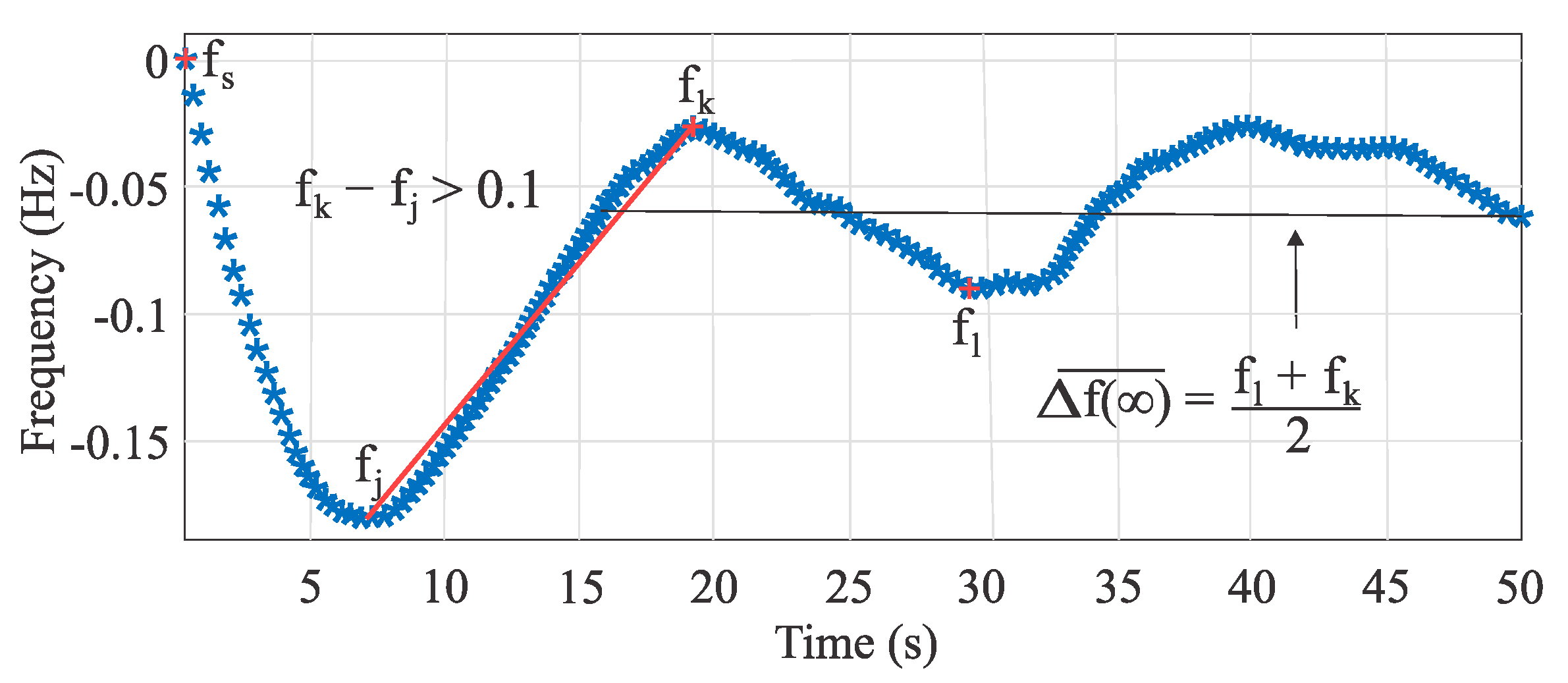

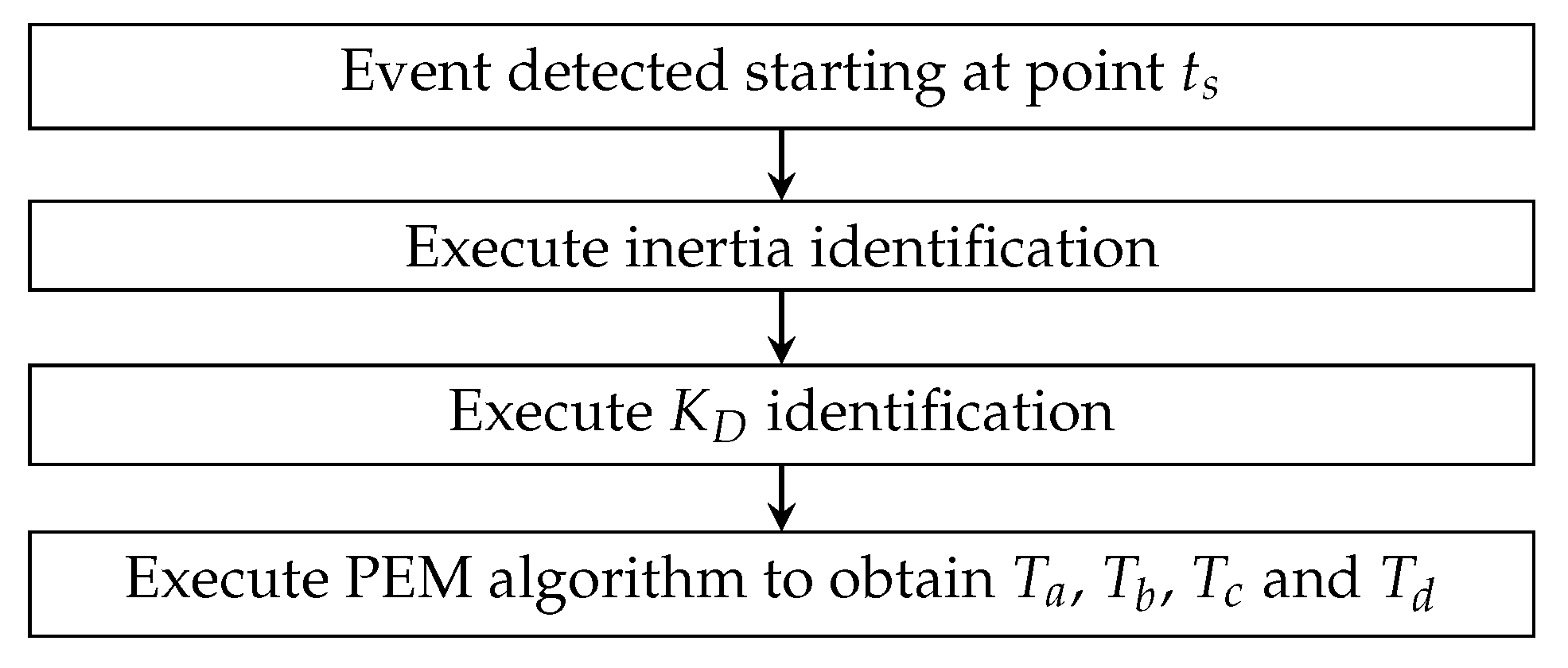

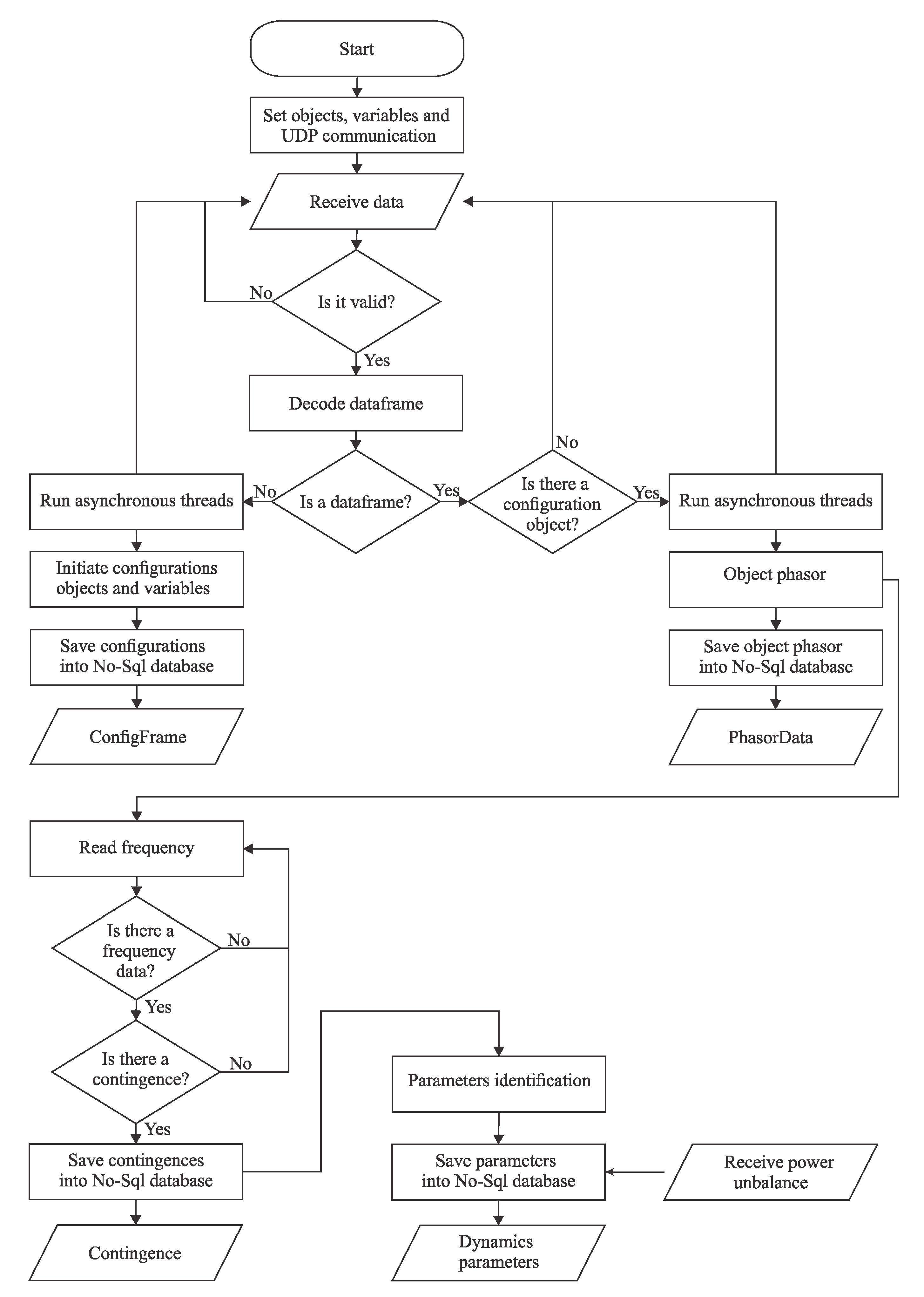


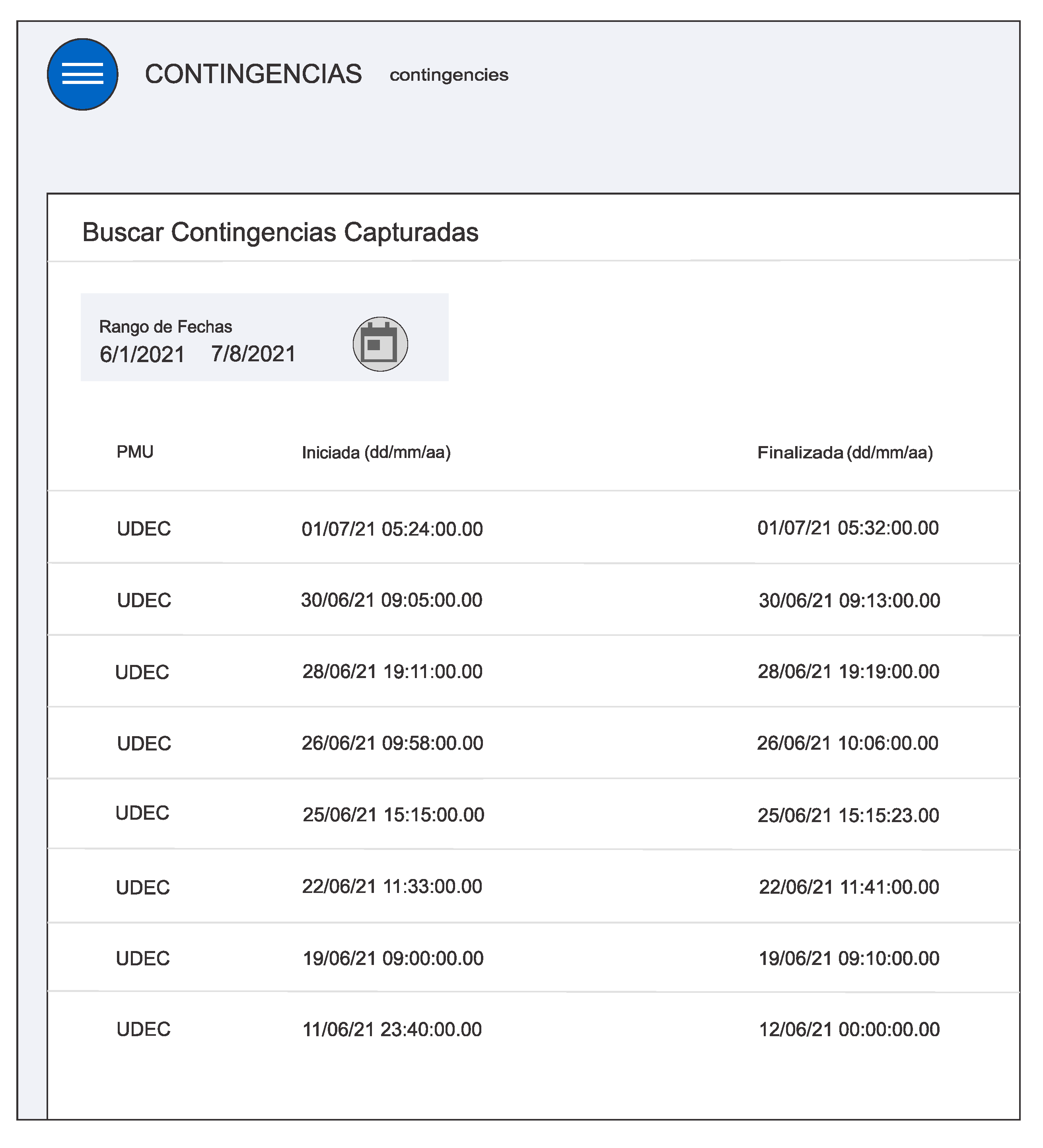
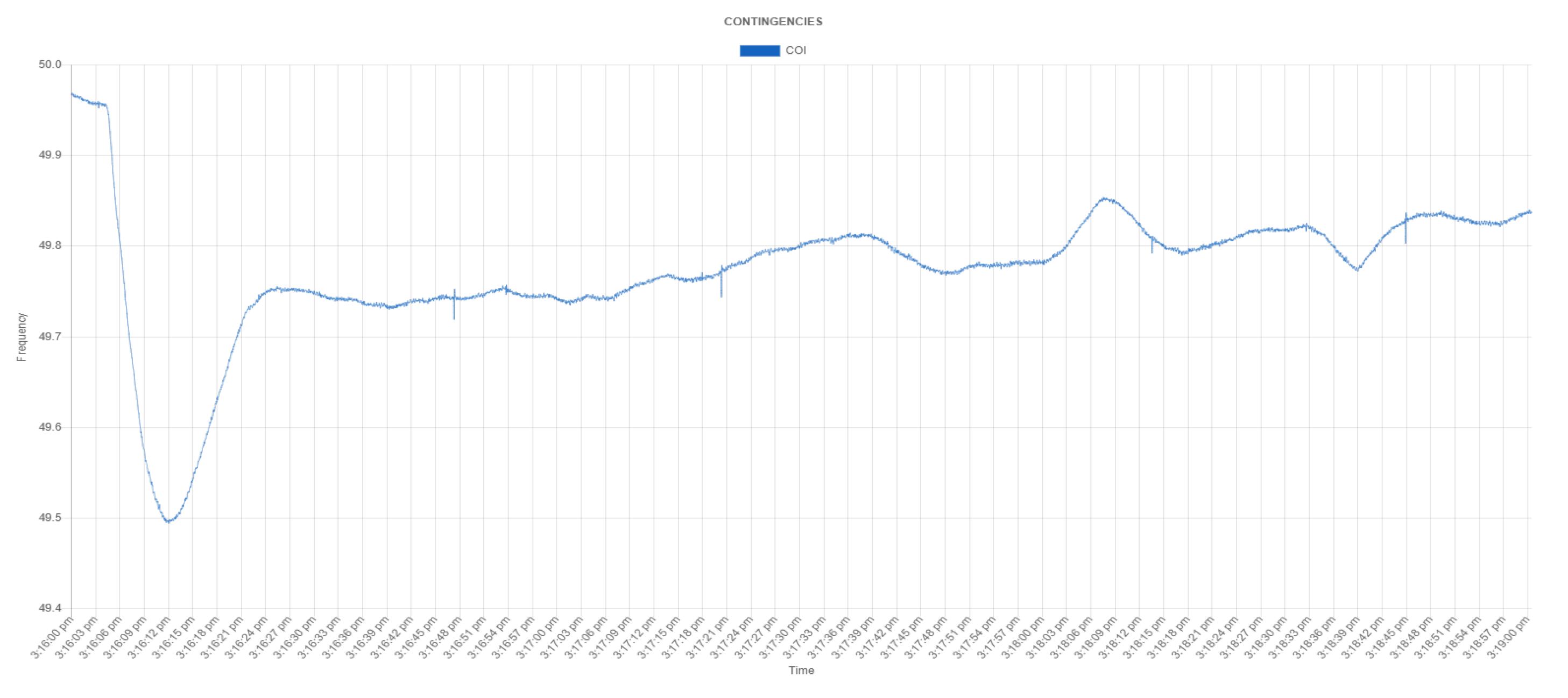

Publisher’s Note: MDPI stays neutral with regard to jurisdictional claims in published maps and institutional affiliations. |
© 2022 by the authors. Licensee MDPI, Basel, Switzerland. This article is an open access article distributed under the terms and conditions of the Creative Commons Attribution (CC BY) license (https://creativecommons.org/licenses/by/4.0/).
Share and Cite
Quiroz, J.; Gonzalez, L.; Chavez, H.; Segundo, F. Data-Driven, Web-Based Parameter Identification for a Reduced-Order Model of the Chilean Power System. Energies 2022, 15, 3384. https://doi.org/10.3390/en15093384
Quiroz J, Gonzalez L, Chavez H, Segundo F. Data-Driven, Web-Based Parameter Identification for a Reduced-Order Model of the Chilean Power System. Energies. 2022; 15(9):3384. https://doi.org/10.3390/en15093384
Chicago/Turabian StyleQuiroz, Juan, Luis Gonzalez, Hector Chavez, and Felix Segundo. 2022. "Data-Driven, Web-Based Parameter Identification for a Reduced-Order Model of the Chilean Power System" Energies 15, no. 9: 3384. https://doi.org/10.3390/en15093384
APA StyleQuiroz, J., Gonzalez, L., Chavez, H., & Segundo, F. (2022). Data-Driven, Web-Based Parameter Identification for a Reduced-Order Model of the Chilean Power System. Energies, 15(9), 3384. https://doi.org/10.3390/en15093384






